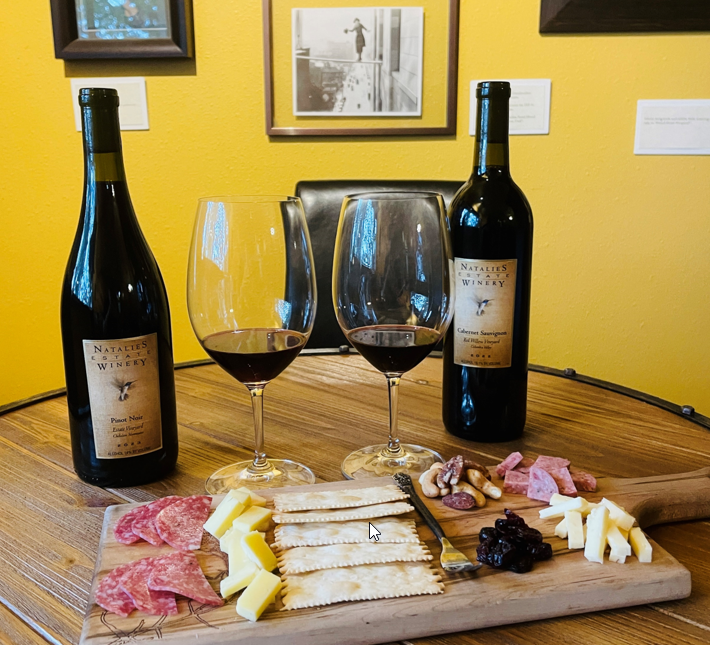Wine lovers often hear the terms warm climate wines and cool climate wines tossed around, but what do they really mean? And how do they affect what’s in your glass? At Natalie’s Estate Winery, a family-owned winery in Oregon, we believe that understanding the difference between warm and cool climate wines helps deepen your appreciation of every sip.
Warm vs Cool Climate Wines: The Basics
When we talk about wine climate comparison, we’re really discussing how temperature and growing conditions shape the grapes.
- Warm Climate Wine Regions: Places like California’s Napa Valley, Australia’s Barossa Valley, Spain’s Rioja, and the Columbia & Yakima Valleys in Washington. These areas enjoy long, hot summers with abundant sunshine. Grapes ripen fully and develop high sugar levels. The result? Warm climate red wines that are rich, bold, and fruit-driven.
- Cool Climate Wine Regions: Think of Burgundy and Champagne in France, Germany’s Mosel, or the Oregon cool climate wines of the Willamette Valley. Grapes ripen more slowly, retaining bright acidity and delicate flavors. This creates elegant, nuanced wines with freshness and finesse.
How Climate Shapes Wine
Warm Climate Wines
Wines from warm areas are typically:
- Brimming with ripe, jammy fruit flavors like blackberry, plum, and tropical fruits
- Fuller-bodied and lush
- Softer in acidity, creating a rounder mouthfeel
- Higher in alcohol due to increased sugar levels
A warm climate red wine, such as Syrah or Cabernet Sauvignon from Washington or California, showcases richness, power, and depth.
Cool Climate Wines
Wines from cooler regions are known for:
- Red and bright fruit flavors like cherry, raspberry, and cranberry
- Refined, lighter body and structure
- Crisp, lively acidity
- Lower alcohol levels with more balance
A cool-climate Pinot Noir from Oregon is a textbook example—layered, earthy, and food-friendly, with bright red fruit and subtle spice notes.
Why It Matters for Wine Lovers
Understanding the difference between warm and cool climate wines helps you choose bottles that suit your preferences. If you love bold, fruit-forward styles, consider exploring wines from warm-climate wine regions. If you prefer vibrant acidity and elegant structure, look to cool climate wine regions.
It also impacts age-worthiness: cool-climate wines with higher acidity often age gracefully, while warm-climate wines tend to show their best in youth.
Oregon Cool Climate Wines at Natalie’s Estate Winery
Here in Oregon’s Willamette Valley, our vineyards thrive in a true cool climate wine region. At Natalie’s Estate Winery, our estate-grown Pinot Noir reflects this terroir—showing freshness, lively acidity, and graceful complexity. As a boutique winery in Oregon, we craft wines that highlight the finesse of our cool climate.
However, we also partner with growers in warm-climate wine regions, such as Oregon and Washington’s Columbia Valley, to produce warm-climate red wines, including Cabernet Sauvignon and Syrah. This allows our guests to taste both styles side by side—an authentic wine climate comparison.
Tasting the Difference
One of the best ways to understand warm vs cool climate wines is through experience. During Natalie’s Estate wine tasting, you can explore the differences firsthand. Compare a cool climate Pinot Noir from Oregon with a bold Cabernet from a warmer region. The contrast brings the concept to life.
For an even deeper dive, join us for a barrel tasting at Natalie’s Estate. You’ll sample wines still developing in oak, gaining insight into how climate and aging shape their flavors. Whether you’re joining us for a wine tasting in the Willamette Valley or visiting for a wine tasting in Newberg, Oregon, you’ll discover how climate tells a story in every glass.
Final Sip
The beauty of wine lies in its diversity. Warm climate wines bring lush ripeness and boldness, while cool climate wines offer elegance, freshness, and restraint. Neither is better—just different expressions of nature and place.
At Natalie’s Estate Winery, we invite you to taste both styles. As a family-owned winery in Oregon, our mission is to share handcrafted wines that reflect the land, climate, and care that went into their creation. Join us for a Natalie’s Estate wine tasting in our estate tasting room during one of our special events, or at a special barrel tasting at Natalie’s Estate to explore how climate shapes the journey from vineyard to glass.

